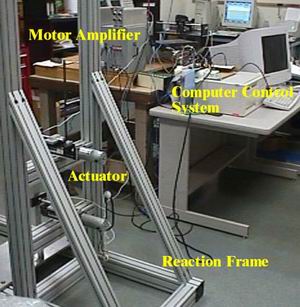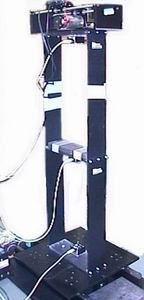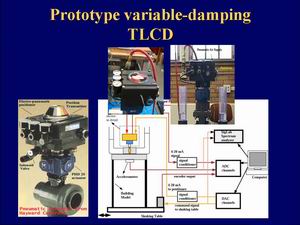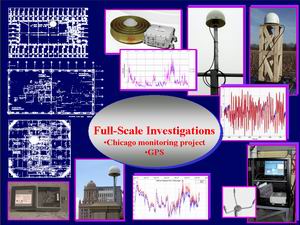 |
|
|
| |
|
| |
|
|
| |
|
|

 Resources at NatHaz Laboratory Resources at NatHaz Laboratory |
 |
The laboratory has various laboratory scale experimental set-up for modeling dynamic load effects.
These are in tandem with the Atmospheric Wind Tunnel in the Hessert Center for Aerospace Research which has the wind tunnel facilities.
| The Dynamic Load Simulator (DLS) is set-up with a two-level model connected to 2 actuators
which can dynamically load the structure with correlated wind, wave and earthquake loading. |
 |
 |
A 2-story building module Quanser Consulting with
an Active Mass Damper (AMD) module for verification of control strategies.
Two small Shaking Tables are also installed in the laboratory to conduct experiments for simulation of earthquakes
and basic dynamics studies. |
| The laboratory includes a Tuned Liquid Damper (TLD) which is a type of TMD where the mass is replaced by a liquid (usually water).
Tuned Liquid Column Dampers (TLCDs) are a special type of TLDs relying on the motion of a column of liquid in a U-tube
like container to counteract the forces acting on the structure.
The advantages of TLCD systems include low cost and maintenance and most importantly,
such containers can be utilized for building water supply,
unlike a TMD where the dead weight of the mass has no other functional use.
|
 |
 |
The laboratory also includes a network of instrumented tall buildings in Chicago that includes conventional instrumentation, e.g.,
accelerometers, ultrasonic anemometers and real-time kinematic(RTK) high precision GPS system.
A web evaluated data acquisition system is developed for data transmission, analysis, archiving and retrieving.
- http://windycity.ce.nd.edu
|
Hammer kit from Modal Shop is available for modal analysis and
SIGLAB (DSPT technology) is used for MATLAB based time-domain and spectrum analysis.
The laboratory also has various data acquisition and control implementation software like DSpace, WinCon and LabView.
Computational resources include four dedicated pentium computers for data acquisition and a SunSparc UltraUnix workstation for analysis.
The labaratory also has a wide range of sensors ranging from laser sensor displacement sensors, 6 degree-of-freedom load cells,
pressure transducers, accelerometers, LVDTs, etc. and associated signal conditioning units and synchronous pressure measurement system.
 Resources at Hessert Center for Aerospace Research Resources at Hessert Center for Aerospace Research |
 |
 Atmospheric Wind Tunnel Atmospheric Wind Tunnel
The atmospheric wind tunnel at Hessert Center is an open circuit type tunnel with a length of 67 feet
(20.42 m). The test section has a 5 feet by 5 feet (1.52 m x 1.52 m) cross-section and is 45 feet (13.7 m) long.
The tunnel has several features which make it unique compared to other atmospheric tunnels.
The majority of existing facilities extract the turbulent fluctuating energy from the mean flow
by using the roughness elements at the wall as obstacles in the mean flow. In Notre Dame's tunnel,
arrays of symmetrical side jets in the turbulence box located ahead of the test section are used;
thus, the turbulent fluctuating energy is not exclusively extracted from the mean flow.
Turbulence intensities from 20-25% with length scales from 4 to 5 inches (10 to 13cm) can be obtained with this side jet system.
Another important feature is that the strength, as well as the distribution of the jets, can be controlled.
This tunnel has been used to produce a simulated atmospheric surface layer with the proper characteristics.
The tunnel can also be operated as a conventional low speed/low turbulence, 1% or less tunnel
with a maximum speed to 50 feet/second (15.25 m/s).
Current research includes studies of the turbulence effects on the aeroelastic stability of long, suspended-span bridges.
 |
 |
|
|
|
Copyright (c) 2003 NatHaz Modeling Laboratory. All rights reserved.
|
|








